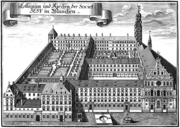.gif)
Old Academy (Munich)
Encyclopedia

Munich
Munich The city's motto is "" . Before 2006, it was "Weltstadt mit Herz" . Its native name, , is derived from the Old High German Munichen, meaning "by the monks' place". The city's name derives from the monks of the Benedictine order who founded the city; hence the monk depicted on the city's coat...
, Germany
Germany
Germany , officially the Federal Republic of Germany , is a federal parliamentary republic in Europe. The country consists of 16 states while the capital and largest city is Berlin. Germany covers an area of 357,021 km2 and has a largely temperate seasonal climate...
. Dating from the 16th century, it has a Renaissance
Renaissance architecture
Renaissance architecture is the architecture of the period between the early 15th and early 17th centuries in different regions of Europe, demonstrating a conscious revival and development of certain elements of ancient Greek and Roman thought and material culture. Stylistically, Renaissance...
facade and four inner courtyards.
History
William V, Duke of BavariaWilliam V, Duke of Bavaria
William V, Duke of Bavaria , called the Pious, was Duke of Bavaria from 1579 to 1597.- Education and early life :...
ordered the construction of a building for the college and the school of the Jesuits next to his St. Michael's Church
St. Michael's Church, Munich
St Michael is a Jesuit church in Munich, southern Germany, the largest Renaissance church north of the Alps. The style of the building had an enormous influence on Southern German early Baroque architecture.-Architecture:...
. The college was established 1583-1590. It is unclear who designed the building, but it was probably as Friedrich Sustris
Friedrich Sustris
Friedrich Sustris was a German-Dutch painter, decorator and architect. He was a son of the artist Lambert Sustris, who worked in Italy....
.
After the expulsion of the Jesuits in 1773 the building became a cantonment for cadets of the army. From 1783 to 1826, it housed the Court Library and Archives, and then a school of painting and sculpture (hence the designation "Academy"). From 1826 to 1840, the Ludwig Maximilian University had its temporary domicile in the building. After severe destruction during the Second World War (1944) it was rebuilt by Josef Wiedemann to house the Bavarian Statistical Office.

